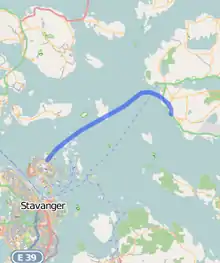Ryfast
Ryfast is a sub-sea tunnel system in Rogaland county, Norway.[1] The tunnel system is part of the Norwegian National Road 13 and it runs between the city of Stavanger in Stavanger Municipality, under a large fjord, and the area of Solbakk in the municipality of Strand.[2]

When the last section was drilled on 26 October 2017, Ryfast became the longest undersea road tunnel in the world, with its 14.3 kilometres (8.9 mi) length greater than the Eysturoyartunnilin in the Faroe Islands at 11.2 kilometres (7.0 mi), the Tokyo Bay Tunnel in Japan at 9.6 kilometres (6.0 mi), and the Shanghai Yangtze River Tunnel at 9.0 kilometres (5.6 mi) in China.[3] It is also currently the world's deepest subsea tunnel, reaching a maximum depth of 292 metres (958 ft) below sea level.[4][5]
The project was approved by the Norwegian Parliament on 12 June 2012 and construction began in the spring of 2013. The cost of Ryfast is estimated to 5.22 billion kr (Norwegian krone).[6] The tunnel system replaced the ferry route between Stavanger and Tau as well as the ferry from Oanes to Lauvik across the Høgsfjorden.
The tunnel system consists of two subsea tunnels:
- Ryfylke Tunnel, 14,400 metres (47,200 ft), running from the island of Hundvåg to just south of the village of Tau in Strand municipality on the other side of the fjord. This tunnel reduced travel time between the Northern Jæren and Ryfylke districts in Rogaland county.
- Ryfylke officially opened to traffic at noon on 30 December 2019.[7]
- Hundvåg Tunnel, 5,500 metres (18,000 ft), running from the city of Stavanger to the island of Hundvåg, with a connection to the smaller island of Buøy. This tunnel relieved congestion on the Stavanger City Bridge.
- While the first section of Hundvåg was opened for a celebration in December 2019, the official opening for vehicles was delayed to 22 April 2020, due to extra technical testing, which was slowed due to the impact of the COVID-19 pandemic in Norway.[5][8]
The Ryfast tunnel system was built at the same time as the 3,700 m (12,100 ft) Eiganes Tunnel, which was constructed from a similar starting point as the Hundvåg, under the city of Stavanger, but stays in (under) the city rather than continuing undersea.[6] The Eiganes, like the Hundvåg, opened on 22 April 2020.[5][8]
References
- Andersen, Atle (2013-03-01). "Her forberedes Ryfast-byggingen". Stavanger Aftenblad (in Norwegian).
- "Ryfast" (in Norwegian). Statens vegvesen.
- "Nå er siste fjellrest sprengt vekk i verdens lengste undersjøiske veitunnel". 26 October 2017.
- "World's Deepest Subsea Tunnel Opens in Norway". New Civil Engineer. 6 January 2020.
- "Fakta om Ryfast-prosjektet" (in Norwegian). Statens vegvesen. 22 April 2020.
- Nå bygger vi Ryfast og Eiganestunnelen [We are Now Building Ryfast and the Eiganes tunnel] (PDF). Norwegian Public Roads Administration (Report) (in Norwegian). January 2013.
- Topdahl, Rolv Christian; Einervoll Nilsen, Ruth; Nesvik, Morten; Laugaland, Johan Mihle (30 December 2019). "Verdens lengste undersjøiske tunnel har åpnet" [The World's Longest Underwater Tunnel has Opened]. NRK (in Norwegian).
- "Hundvåg- og Eiganestunnelen: Datoen klar for når sperringene fjernes og trafikken slippes fram" [Hundvåg and Eiganes tunnel: The date ready for when the barriers are removed and traffic is released]. Stavanger Aftenblad (in Norwegian). 16 April 2020. Retrieved 27 December 2020.